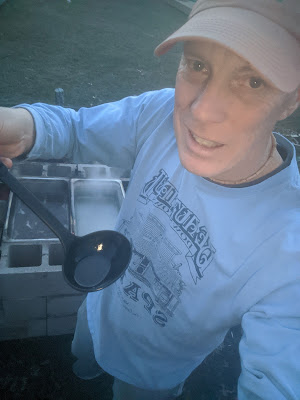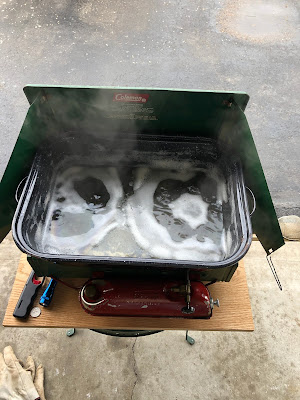When the sap is rising in our maple, I know it is rising in thousands of other trees as well, and my expectations rise with it - winter is coming to an end. When the dripping sap slows down or stops, so has the advance of spring.
(Arnosky, Jim. Nearer Nature. Lothrop Lee & Shepard, 1996, p. 44.)
From as far back as I can remember, my family has marked the changing of the seasons, from winter to spring, by collecting the sap of maple trees; boiling it down to syrup. It was not the thick, goopy, substance sold in stores, whose primary ingredient was extracted from corn. What we created was precious. Its main ingredients were time, effort, and patience. The desired result was liquid gold!
The first stove that we used for boiling down the sap was an old, steel, 30 gallon drum; custom cut and welded with a hinged door - courtesy of the Gaylord High School shop class. That original was upright and held one large pot to which Dad kept adding fresh sap. The wood was cut to fit and split to provide the heat necessary that kept the sap at a rolling boil. Later we improved upon that design with a barrel that laid horizontal and allowed us to use two large pans at the same time; doubling our output.
Our source for the sap were the maple trees along the fenceline surrounding our property; up on the hills north of the small community of Sparr, in the Great Lake State of Michigan. Those same species of trees supplied our sap when we built a new house and moved to what we had simply called, “The Property;” just west of Sparr and nestled up against the backside of Sylvan Knob Ski Area. The land behind our home and barnyard was full of maples, in addition to beech, ironwood, hemlock, basswood, and the skeletal remains of the American elm, recently plagued by the introduced Dutch Elm Disease.
We cut our own firewood that we used to not only heat our own home, but to boil the sap in the springtime as well. Using the hills and gravity to our benefit, we’d roll dead and dried out logs down into the valleys where our Welsh pony, Hercules, would help skid them out to our hidden “Sugar Shack” tucked away in the grove of red pines behind our homestead. There the hardwood logs were stacked until sap was gathered and boiling commenced.
By then we had gotten ahold of an old 2x5 foot, genuine sap boiler from Mr. Crandall, a teaching colleague of my Dad’s. All it needed was a little soldering, and some elbow grease with a handful of steel wool, to increase our output. We suspended the boiler upon cinder blocks that we carefully leveled within the shack. The shack itself was framed out of cedar logs that were cut from the swampland belonging to the Elenz’s; back beyond the hills and just off Sparr Road - alongside the headwaters of the Pigeon River. The metal roof was from the remnants of our pole barn that had been built by Bailey Sides (who had been our neighbor and who had also built our house). The three walls were made of scrap slab wood, graciously given to us by the Meades from their sawmill on top of Sylvan Knob. The slabs were nailed horizontally to the cedar posts and provided little gaps where you could peek out between the curves in the wood. In other words, it was a community of gifts, from bartering and love, that helped to put our sugar camp together. Even the metal sap buckets that hung on our trees were one gallon fruit cans salvaged from the school lunchroom; their individually tuned sounds providing a symphonic chorus in the woods with each fresh drop.
 |
| Karen & Becky Collecting Sap Sparr Michigan April 1981 |
 |
| My Sisters And I At The Sugar Shack - 1981 |
 |
| Karen Next To The Sap Boiler In The Shack - 1981 |
These are just some of my syruping memories that run in conjunction with our family’s history. There are more stories and descriptions of course, that involve Mom finishing the boiling up in the house in order to properly can it, the mighty swings and broken ax handles, jars of syrup used as Christmas gifts for family members, or evening conversations at the shack while sitting on a stump and surrounded by woodsmoke.
The good news is that those memories that were made, and the experiences my sisters and I had with our parents in the Northwoods, made an impact. Perhaps that’s why I’ve gotten back into it now as an adult. It’s part of my heritage, and in my blood. Maple syrup, that sweet liquid gold of spring!
See you along The Way…
-------------------------------------------------
 |
| Back In The Red Pine Grove - Sparr 2009 |
 |
| Owned By Someone Else Now The Sugar Shack Still Stands Showing My Kids In 2009 (Jodi & Todd) |
 |
| A Former Maple Valley Now Grown Into A Tunnel |
PICTURES & VIDEOS FROM SYRUPING
2021
 |
| Packing A Trail To The Maple Trees Along The Old Fence Line At School On The Illinois-Wisconsin Stateline |
 |
| Cindy Helping To Filter Out The Sugar Sand Before Canning The Syrup |
 |
| The First Year's Batch |
 |
| Taste Testing The Syrup In My "Beautiful Downtown Sparr" Shirt! (As it States, "The Center Of The Universe") |
 |
| Ran A Little More Hot Than Usual |
 |
| Our Second Year's Batch |
 |
| Just Across The Stateline Into Wisconsin Dad's Still Doing A Bit Of Syruping As Well From Trees In Their Backyard |
 |
| Mom & Dad Enjoying a Little Campfire |
 |
| Dad Used His Classic Coleman Stove To Boil Down Several Pints |















